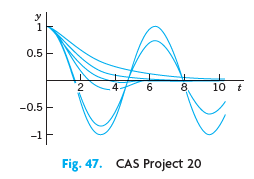Study this transition in terms of graphs of typical solutions. (Cf. Fig. 47.) (a) Avoiding unnecessary generality
Question:
Study this transition in terms of graphs of typical
solutions. (Cf. Fig. 47.)
(a) Avoiding unnecessary generality is part of good
modeling. Show that the initial value problems (A)
and (B),
(A)
(B) the same with different c and (instead
of 0), will give practically as much information as a
problem with other m, k, .
(b) Consider (A). Choose suitable values of c,
perhaps better ones than in Fig. 47, for the transition
from Case III to II and I. Guess c for the curves in the
figure.
(c) Time to go to rest. Theoretically, this time is
infinite (why?). Practically, the system is at rest when
its motion has become very small, say, less than 0.1%
of the initial displacement (this choice being up to us),
that is in our case,
(11) for all t greater than some .
In engineering constructions, damping can often be
varied without too much trouble. Experimenting with
your graphs, find empirically a relation between
and c.
(d) Solve (A) analytically. Give a reason why the
solution c of , with the solution of
, will give you the best possible c satisfying
(11).
(e) Consider (B) empirically as in (a) and (b). What
is the main difference between (B) and (A)?

Step by Step Answer:







